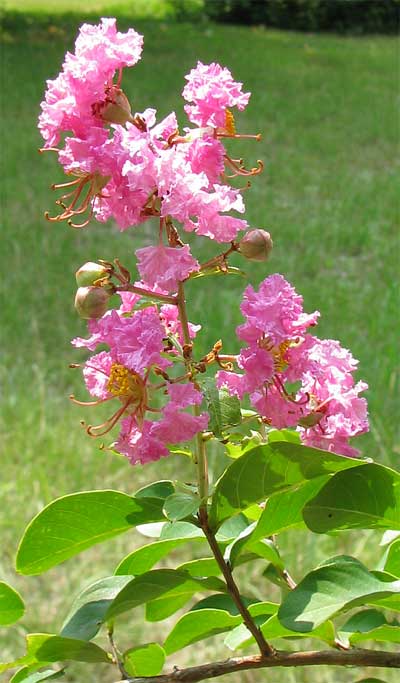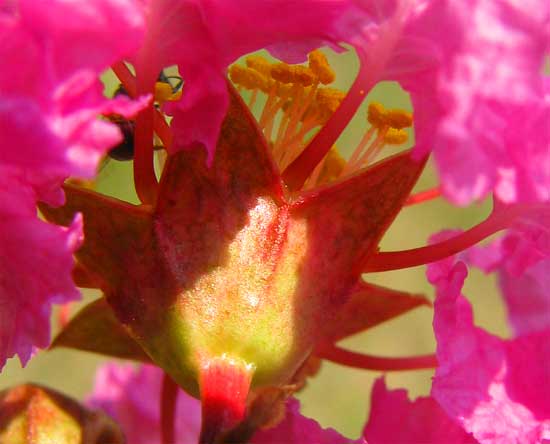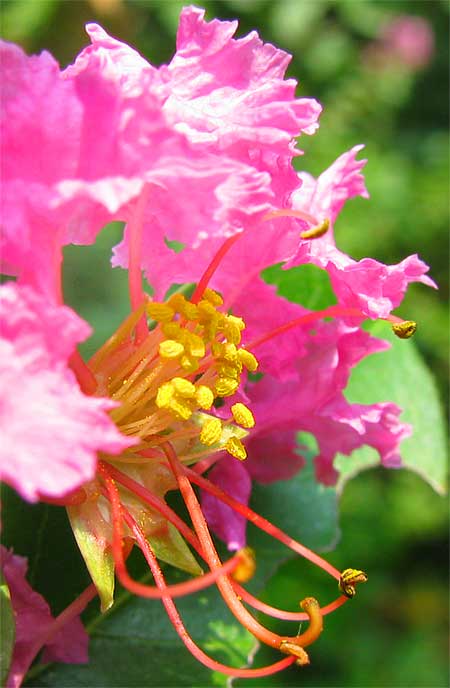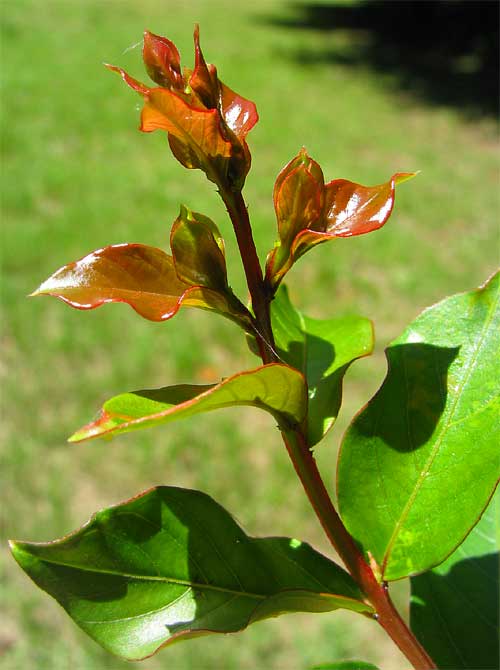Excerpts from Jim Conrad's
Naturalist Newsletter
from the July 7, 2008 Newsletter, issued from the forest near Natchez, Mississippi; elevation ~400ft (120m), ~N31.47°, ~W91.29°:
CRAPE-MYRTLES FLOWERING

At this time of year towns in this area and little houses along roads are just resplendent with flowering Crape-Myrtles, LAGERSTRO-EMIA INDICA. That's a flowering Crape-Myrtle branch at the right.
If we accept that "myrtles" are members of the Myrtle Family, the Myrtacea, then Crape-Myrtles aren't myrtles because they belong to the Loosestrife Family, the Lythraceae. The Loosestrife Family is mostly a tropical American one, more or less recogniable by having two leaves at each stem node (they're opposite), and the flowers' calyx tubes bearing petals at their mouths. Crape-Myrtle flowers show this latter feature beautifully, for their frilly, ping-pong-paddle-shaped petals arise from atop the calyx tube (the hypanthium) on slender "handles," or claws, inserted between the calyx tube's triangular sepals. You can see this by looking at a flower from behind, as at below:

Below is a frontal view of a flower showing the Crape-Myrtle flower's many (36-42) male stamens.

In that picture the yellow, oval objects are the stamens' baglike anthers splitting open and releasing pollen. The anthers are held aloft by slender, reddish filaments. You can see that some filaments are longer than others. Also, there's one long, slender, reddish thing in the picture without an anther atop it. It's the downward-curving, upturned-at-the-tip, second-lowest filament-like thing. The reason it bears no anther is that it's the long neck of the female ovary, referred to as the style. Atop the style the blunt, rough-looking area is the stigma, where pollen grains germinate, send their pollen tubes like roots down through the style, to the greenish ovary unseen beneath the stamen bouquet.
Crape-Myrtles are originally from Asia. Among the reasons they're so common here is that they're tough plants easy to propagate. In early winter just cut off some switches about eight inches long and half an inch thick, stick them in containers of potting soil or well drained garden soil with about an inch of the cutting protruding above the soil line. Leave the pots outside, but protected from severe freezes. Once new growth emerges place the containers in a sunny place and keep watered until they can be set out.
from the July 7, 2008 Newsletter, issued from the forest near Natchez, Mississippi; elevation ~400ft (120m), ~N31.47°, ~W91.29°:
A CRAPE MYRTLE'S NEW, REDDISH SPROUTS
A Crape Myrtle, Lagerstroemia indica, near my trailer is issuing new sprouts, and they're deeply reddish colored, as shown below

In the photo you can see that the older, lower leaves are green, so why are the plant's new leaves reddish?
As leaves and stems emerge, their green chlorophyll and chloroplasts must be synthesized. During this process, developing chloroplasts can be damaged by the sun's ultraviolet radiation. Red pigment in the leaves provides a kind of sun screen for the more fragile green parts.
The red pigments in young shoots and leaves are the same anthocyanins that make fall's leaves red. When I was a student the role of red-pigment anthocyanins in plant tissue was little appreciated, but now it's understood that they play critical roles in a plant's life. Most of the anthocyanins' workings are so subtle and complex that they can only be explained in rather technical terms. You may be interested in a technical paper on the matter.